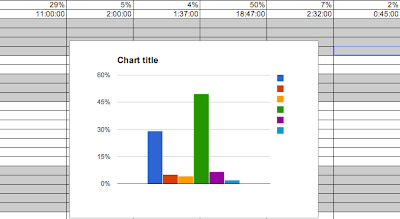![]() There is something truly wonderful about being able to track stats and progress during the language learning process. In fact, this was one of the things that originally drew me to studying online with Skritter and other language learning resources. Being able to visualize time spent and overall progress is just the kind of motivation necessary to keep me coming back for more and better results.
There is something truly wonderful about being able to track stats and progress during the language learning process. In fact, this was one of the things that originally drew me to studying online with Skritter and other language learning resources. Being able to visualize time spent and overall progress is just the kind of motivation necessary to keep me coming back for more and better results.
The other wonderful thing about visualization and stat tracking is the ability to make adjustments to the study routine. Making adjustments to the meta of the language learning process. Left to my own devices, it would be far easier psychologically to assume that whatever tactics I’m using are working without a hitch, than make any real changes. Numbers, however, don’t lie. When weekly or monthly retention rates get too low, or I’m forgetting characters just as fast as I’m learning new ones I can address and fix those issues, but only because of the feedback provided by programs like Skritter.
Progress graphs and statistic tracking is a great, dare I say necessary?, tool provided by services online, but what I’m more interested in for today’s post is setting up a system to make adjustments and tweaks to personal study habits that happen offline. More specifically, we’ll be exploring the use of time tracking as a part of a healthy study routine.
As a language teacher it is my responsibility to focus on and develop the four areas, or skills, of language acquisition: listening, speaking, reading, and writing (mostly composition rather than actual character practice). Classroom activities and take home work is specifically designed to target and develop these different areas, either in isolation, or in combination. As a language learner, especially one who now operates outside the traditional classroom framework, the development process is more ambiguous; often ignoring some areas of acquisition due to interest… or more often sheer convenience. Mentally, I know this is unhealthy. To be truly proficient in Chinese I should have a command of all the areas of acquisition, even if some are slightly stronger than the others.
In order to overcome my own complacency, I decided to start tracking my daily study routine, knowing that unless I could physically visualize my study process I was very unlikely to make any changes. Starting in November, 2012 I created a simple Google Spreadsheet that I would use to track the time I spent studying/ using Chinese. More importantly, I used the spreadsheet to track what area of language I was using at any given time.
 |
| An example of a given week of language usage. |
Wanting to keep things as simple as possible I created the following fields for tracking:
- Date
- Start Time
- End Time
- Difference
- Description
- Week Total
- All Time
- Type
- Listening
- Reading
- Speaking
- Writing
- Characters
- Other
 |
| Exam Week. 18 hours spent writing in Chinese! |
One week isn’t going to be enough to really make any changes study habits, but by tracking when and more importantly how I was spending my time studying over the course of the past half year, I was able to find and fix the gaps. This was crucial for me during early 2013, when I realized that the time I spent reading in Chinese was consistently less than 10% of total study time. This was a big RED FLAG! By having this data in front of me for analysis I was able to change those bad habits and bring those numbers up to 20-30% of my weekly dose of Chinese study.

